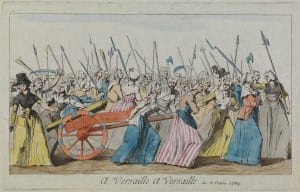Spectacular Revolution
By Martine Rouleau, on 27 May 2016
Blog post for UCL Art Museum, Revolution under a King exhibition by Dr Susannah Walker, UCL Art History Department.
Despite its Enlightenment origins, one of the French Revolution’s legacies is a rich strain of macabre imagery that has entered popular culture: Marie-Antoinette’s hair turning grey at the prospect of the guillotine. The assassinated radical journalist Marat slumped in his bath. The apocryphal tale of the bals des victimes where survivors of the Terror were said to have worn short hair and a red ribbon at the throat in reference to the guillotined head.
The dark humour of popular prints may be at the origin of this cultural response. One bitterly ironic anonymous image of Revolutionary leader Robespierre imagines “having had all the French people guillotined [he] beheads the executioner with his own hand.”
Meanwhile, artists in England, James Gillray and Johann Zoffany expressed opposition to the Revolution’s bloody excesses with bloody and excessive imagery. Zoffany depicted the popular insurrections of August 10th 1792 as orgies of drunken violence while Gillray cast revolutionary working class sans-culottes as cannibals in his Petit-Souper, a la Parisienne of 1792.
Such responses outlived the Revolution itself. Art historian Nina Athanassoglou-Kallmyer has astutely identified the memory of the Terror in the horror novel, a staple in high and low culture epitomised by Jules Janin and Honore de Balzac’s Dead Donkey and the Guillotined Woman (1829). Kallmyer observes that such Gothic entertainments were enjoyed in proximity to the real spectacle of the scaffold which remained part of Parisian life during the Restoration of the French monarchy.
The Revolution’s gory imagery permeated popular entertainment; the phantasmagoria, magic lantern show and Madame Tussaud’s waxworks all tapped into the revolutionary past producing vicarious, disconcertingly affective but “at a distance” experiences of it for their publics through effects of light or wax simulacra.
Recognition of the Revolution’s historical significance, evidenced in its political culture and commemorative prints, took a more literary form in the nineteenth century. Madame Defarge in Charles Dickens’ Tale of Two Cities (1859) echoes Gillray and Zoffany’s earlier works. Victor Hugo’s Les Miserables (1862) drew upon the imagery of the Revolutionary past as the backstory to its representation of the barricades of the 1830s. This taste for the imagery of Revolution was also identifiable in Paul Delaroche’s painting of Marie-Antoinette leaving the convention after her trial (1851). Sentimental, accessible in scale, meticulously conscious of details in its construction of costume and setting, Delaroche’s painting anticipates period dramas of twentieth century television.
The imagery of Revolution remains compelling to present day audiences, Hilary Mantel’s novel A Place of Greater Safety (1992), adapted for radio in 2015, is indicative of this author’s masterful handling of dramatic historical narrative. Last year also saw the Royal Opera’s acclaimed staging Umberto Giordano’s 1896 opera, Andre Chénier set at the height of the Terror. Billed as a “passionate” story in its publicity the hero appears before a tricolore and clouds of smoke, evocative of the phantasmagoria, on its press release.
In tribute to these dramatic spectacular re-constructions of Revolution; UCL Art Museum has invited Art Macabre to join us as part of its “Museums takeover.”
Art Macabre’s successful “Death Drawing Salons” subvert the traditionally precise and simple life drawing class to produce immersive and theatrical tableaux. On 31st May they will stage; Jacques-Louis David’s Marat at his last Breath (1793) and that most panoramic and explosive allegory of the 1830 Revolution Eugène Delacroix’s Liberty Leading the People (1830) as life drawing subjects.
As an art-historian committed to the drawing process as a tool of historical understanding and long-time fan of Art Macabre I’m excited that we can tap into to the spectacular visual culture of the Revolution and consider its ongoing appeal. Join us a glass of wine, one of the last chances to view of the Revolution Under a King exhibition and to experience Revolutionary take on life drawing.
 Close
Close


